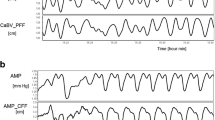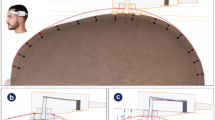Summary
Objective: Cerebrovascular vasomotor reactivity reflects changes in smooth muscle tone in the arterial wall in response to changes in transmural pressure or concentration of carbon dioxide in blood. We have investigated whether slow waves in ABP and ICP may be used to derive an index which reflects reactivity of vessels to changes in arterial blood pressure.
Method: A method for the continuous monitoring of the association between slow spontaneous waves in ICP and AP has been adopted in a group of 98 head injured patients. ABP, ICP and transcranial Doppler blood flow velocity (FV) in the middle cerebral artery was recorded daily (20 to 120 minutes time periods). A Pressure-Reactivity Index (PRx) was calculated as a moving correlation coefficient between 40 consecutive samples of values for ICP and ABP averaged over 5 seconds. A moving correlation coefficient between spontaneous fluctuations of mean FV and CPP (Mx), which was previously reported to describe cerebral blood flow autoregulation, was also calculated.
In an additional 25 patients, PRx was calculated and recorded continuously along with mean ICP, ABP and parameters describing ICP waveform.
Results: A positive PRx correlated with high ICP (r = 0.366; p < 0.001), low admission GCS (r = 0.29; p < 0.01), and poor outcome at 6 months after injury (r = 0.48; p < 0.00001). During the first two days following injury, PRx was positive (p < 0.05) in patients with unfavourable outcome. The correlation between PRx and Mx (r = 0.63) was highly significant (p < 0.000001).
Continuous recordings demonstrated that PRx was able to indicate individual thresholds of vascular reactivity for CPP, ICP, and ventilation parameters.
Conclusion: Computer analysis of slow waves in ABP and ICP is able to provide a continuous index of cerebrovascular reactivity to changes in arterial pressure, which is of prognostic significance.
Access this chapter
Tax calculation will be finalised at checkout
Purchases are for personal use only
Preview
Unable to display preview. Download preview PDF.
Similar content being viewed by others
References
Aaslid R, Lindegaard KF, Sorteberg W, Nornes H (1989) Cerebral autoregulation dynamics in humans. Stroke 20:45–52
Cold GE, Jensen FT (1978) Cerebral autoregulation in unconscious patients with brain injury. Acta Anaesth Scand 22: 270–280
Enevoldsen EM, Jensen FT (1978) Autoregulation and CO2 responses of cerebral blood flow in patients with acute severe head injury. J Neurosurg 48: 689–703
Florence G, Seylaz J (1992) Rapid autoregulation of cerebral blood flow: a laser-Doppler flowmetry study. J Cereb Blood Flow Metab 12: 674–480
Jones SC, Williams JL, Shea M, Easley KA, Wei D (1995) Cortical cerebral blood flow cycling: anaesthesia and arterial blood pressure. Am J Phys 268: H569–H575
Klingelhofer J, Sander D (1991) Dynamics in Cerebral blood flow velocities in sleep. J Cardiovasc Technol 9: 87
Lang EW, Chesnut RM (1995) Intracranial pressure and cerebral perfusion pressure after severe head injury, New Horiz 3: 400–409
Lundberg N (1960) Continuous recording and control of ventricular fluid pressure in neurosurgical practice. Acta Psychiatr Neurol Scand [Suppl] 149:1–193
Muizelaar JP, Ward JD, Marmarou A, Newlon PG, Wachi A (1989) Cerebral blood flow and metabolism in severely head-injured children. Autoregulation. J Neurosurg 71: 72–76
Newell DW, Aaslid R, Stooss R, Reulen HJ (1992) The relationship of blood flow velocity fluctuations to intracranial pressure B waves. J Neurosurg 76: 415–421
Rosner MJ, Rosner SD, Johnson AH (1995) Cerebral perfusion pressure: management protocol and clinical results. J Neurosurg 83: 949–962
Steinmaier R, Bauhuf C, Bondar I, Fahlbusch R (1995) Relationship of spontaneous ICP fluctuations to cerebral blood flow and metabolism in comatose patients. J Neurotrauma 12: 403 (abstr)
Author information
Authors and Affiliations
Editor information
Editors and Affiliations
Rights and permissions
Copyright information
© 1998 Springer-Verlag Wien
About this paper
Cite this paper
Czosnyka, M., Smielewski, P., Kirkpatrick, P., Piechnik, S., Laing, R., Pickard, J.D. (1998). Continuous Monitoring of Cerebrovascular Pressure-Reactivity in Head Injury. In: Marmarou, A., et al. Intracranial Pressure and Neuromonitoring in Brain Injury. Acta Neurochirurgica Supplements, vol 71. Springer, Vienna. https://doi.org/10.1007/978-3-7091-6475-4_23
Download citation
DOI: https://doi.org/10.1007/978-3-7091-6475-4_23
Publisher Name: Springer, Vienna
Print ISBN: 978-3-7091-7331-2
Online ISBN: 978-3-7091-6475-4
eBook Packages: Springer Book Archive




